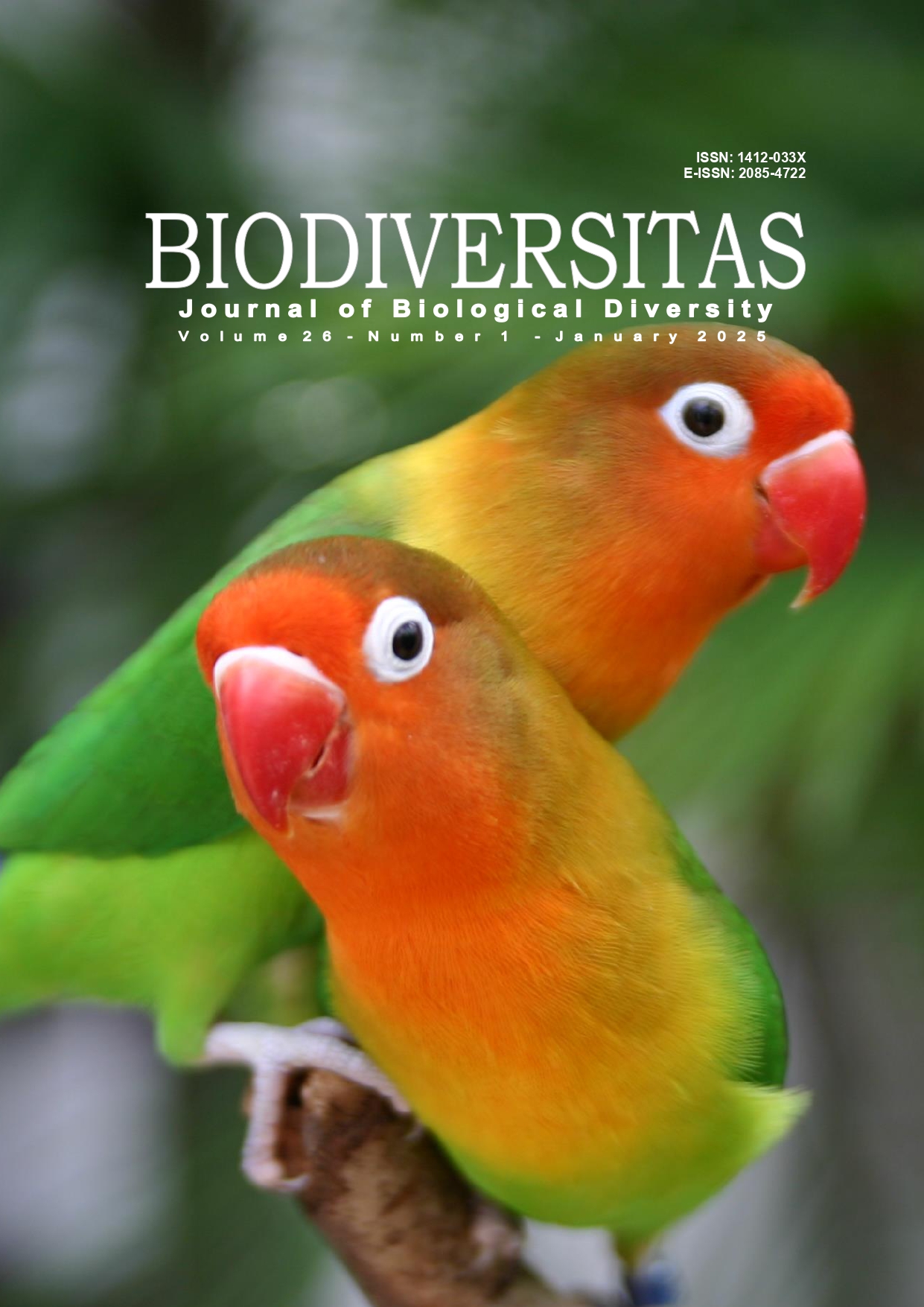Identification of the nettle caterpillar in smallholding oil palm plantation cultivated on peatland in Ogan Ilir, South Sumatra, Indonesia
##plugins.themes.bootstrap3.article.main##
Abstract
Abstract. Anggraini E, Setiawati T, Herlinda S, Irsan C, Mulawarman, Gofar N, Muslim A, Lau WH. 2025. Identification of the nettle caterpillar in smallholding oil palm plantation cultivated on peatland in Ogan Ilir, South Sumatra, Indonesia. Biodiversitas 26: 36-44. Nettle caterpillars are a major pest in oil palm plantations, posing a significant threat to the productivity and sustainability of this crop. These voracious leaf-feeding caterpillars can cause severe damage, hindering plant growth, reducing fruit production, and even leading to the mortality of oil palm trees. This study aimed to identify the species of caterpillars that inflict damage, their physical traits, population densities, and the symptoms of their attacks. This study employed direct observation and documentation of caterpillar species in the field. Observations were conducted to assess the extent of damage inflicted by caterpillars in the field. Subsequently, document using a camera, collect field samples, and identification of the nettle caterpillars found in oil palm plantation cultivated on peatland in Ogan Ilir, South Sumatera, Indonesia. This investigation identified three species of caterpillars: Setora nitens, Birthosea bisura, and Parasa lepida. These three species of caterpillars typically exhibit similar coloration but possess distinct morphological traits. The S. nitens species predominates among the largest number of species. Caterpillars consume both young and mature oil palm leaves, remaining only in the midrib. Additional indications of the attack include perforations in the leaves. The incidence of caterpillar assaults may attain 100% of nettle caterpillar infestation, accompanied by an attack rate of 57.75%. This study concludes that three primary species of nettle caterpillar were identified in oil palm plantations, exhibiting indications of damage classified as fairly severe. Thus, effective management of nettle caterpillars is crucial to maintaining the productivity and profitability of oil palm plantations.
##plugins.themes.bootstrap3.article.details##
Most read articles by the same author(s)
- SUWANDI SUWANDI, MONICA ALESIA, RUDI PUTRA MUNANDAR, RAHMAD FADLI, SUPARMAN SUPARMAN, CHANDRA IRSAN, A. MUSLIM, The suppression of Ganoderma boninense on oil palm under mixed planting with taro plants , Biodiversitas Journal of Biological Diversity: Vol. 25 No. 3 (2024)
- YUWINDA AYU LESTARI, MARIESKA VERAWATY, SITI HERLINDA, Development of Spodoptera frugiperda fed on young maize plant’s fresh leaves inoculated with endophytic fungi from South Sumatra, Indonesia , Biodiversitas Journal of Biological Diversity: Vol. 23 No. 10 (2022)
- NUNI GOFAR, TRI P. NUR, SHINTA D. I. PERMATASARI, SITI MUSLIMAH, HAMDHANIE FIKRI, ANUNG HARYONO, PUJIATI, HANA ALFIANITA UTAMI, Application of organic fertilizer enriched with Trichoderma harzianum on shallot (Allium cepa) cultivation in ultisols , Biodiversitas Journal of Biological Diversity: Vol. 24 No. 4 (2023)
- DETYA ROSA FADDILAH, MARIESKA VERAWATY, SITI HERLINDA, Growth of fall armyworm, Spodoptera frugiperda J.E. Smith (Lepidoptera: Noctuidae) fed on young maize colonized with endophytic fungus Beauveria bassiana from South Sumatra, Indonesia , Biodiversitas Journal of Biological Diversity: Vol. 23 No. 12 (2022)
- INDRI RAMAYANTI, SITI HERLINDA, AHMAD MUSLIM, HAMZAH HASYIM, First report of entomopathogenic fungi from South Sumatra (Indonesia): pathogenicity to egg, larvae, and adult of Culex quinquefasciatus , Biodiversitas Journal of Biological Diversity: Vol. 23 No. 11 (2022)
- ERISE ANGGRAINI, TESSIA MASNITA SINAGA, CHANDRA IRSAN, SITI HERLINDA, AHMAD MUSLIM, HARMAN HAMIDSON, MARLIN SEFRILA, ASTUTI KURNIANINGSIH, DESI ARYANI, MIRZA ANTONI, ZAHLUL IKHSAN, Insects found in different ages of coconut viridis variety in Sri Tiga Village, Banyuasin District, South Sumatra, Indonesia , Biodiversitas Journal of Biological Diversity: Vol. 25 No. 8 (2024)

